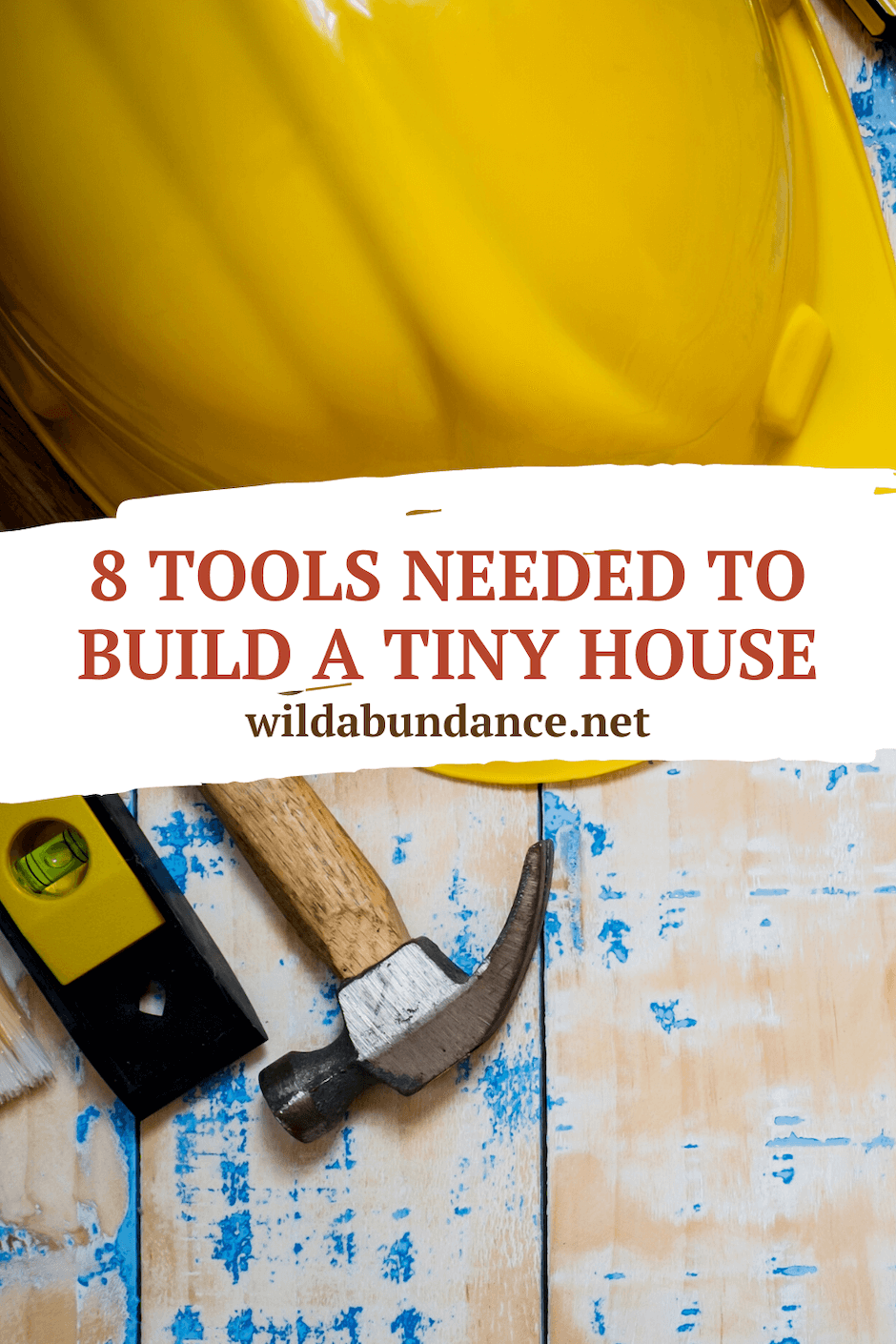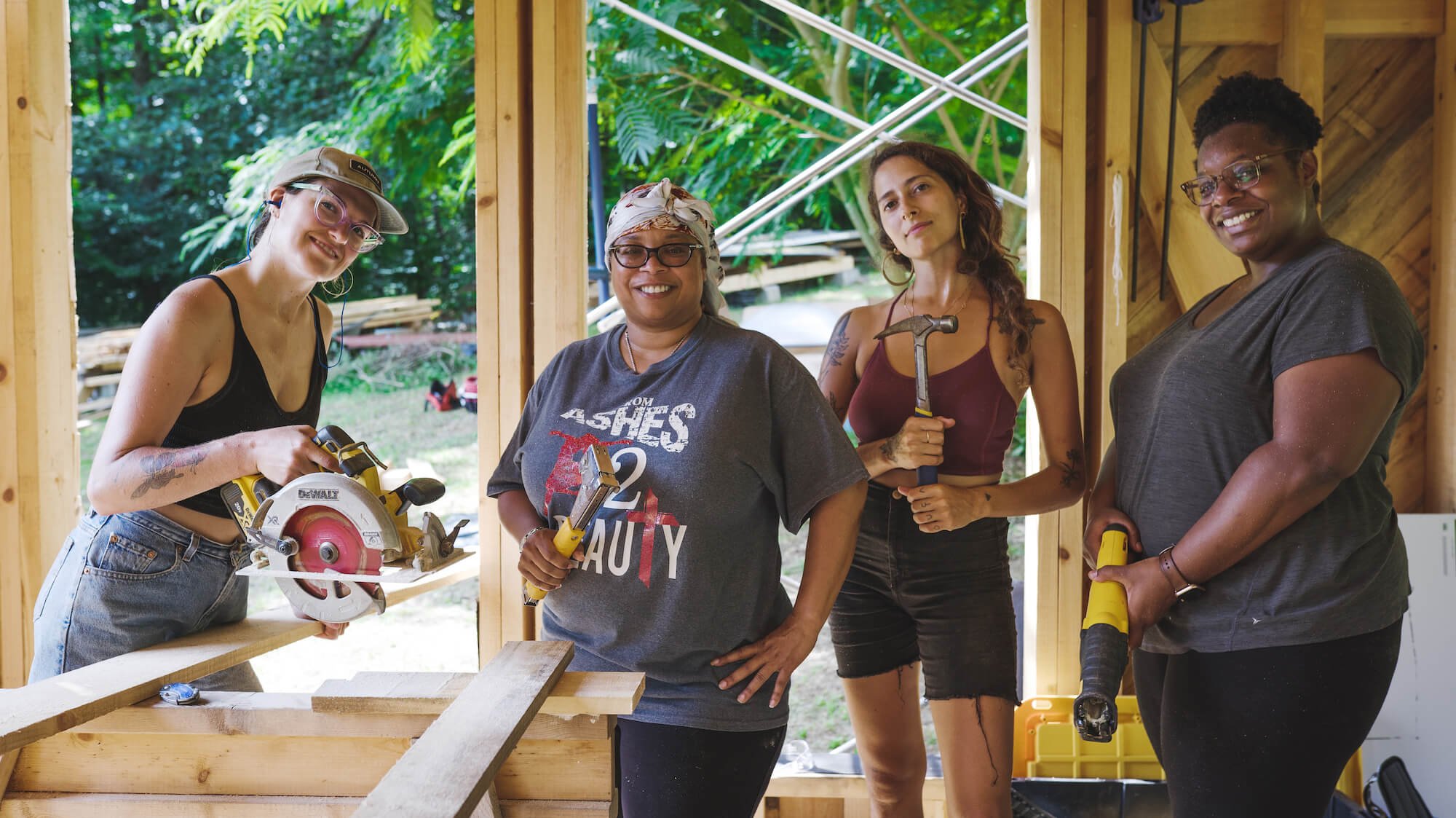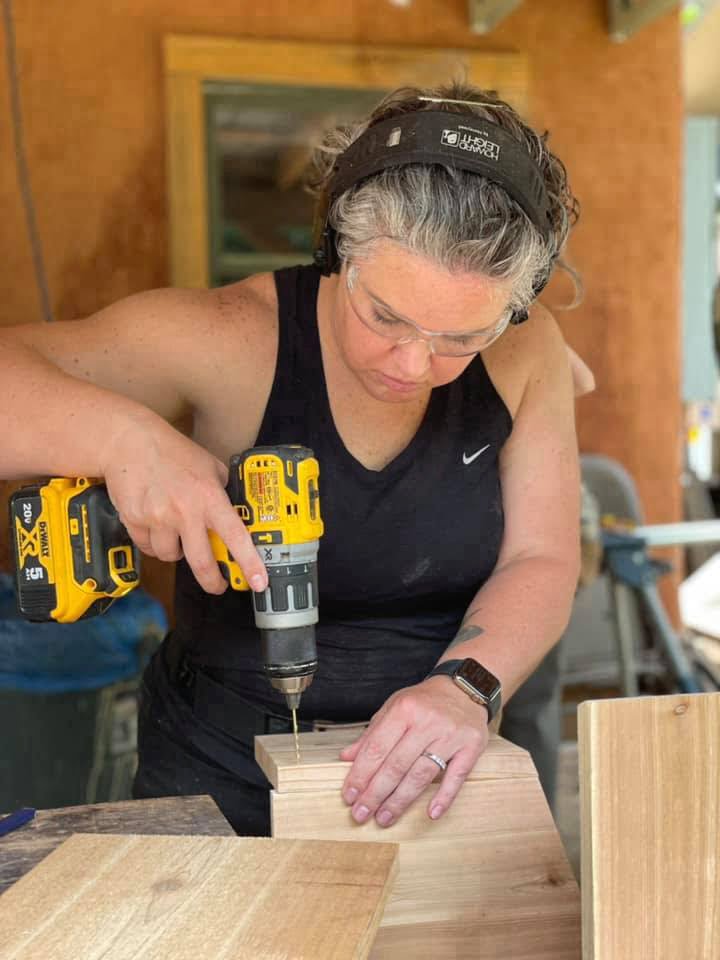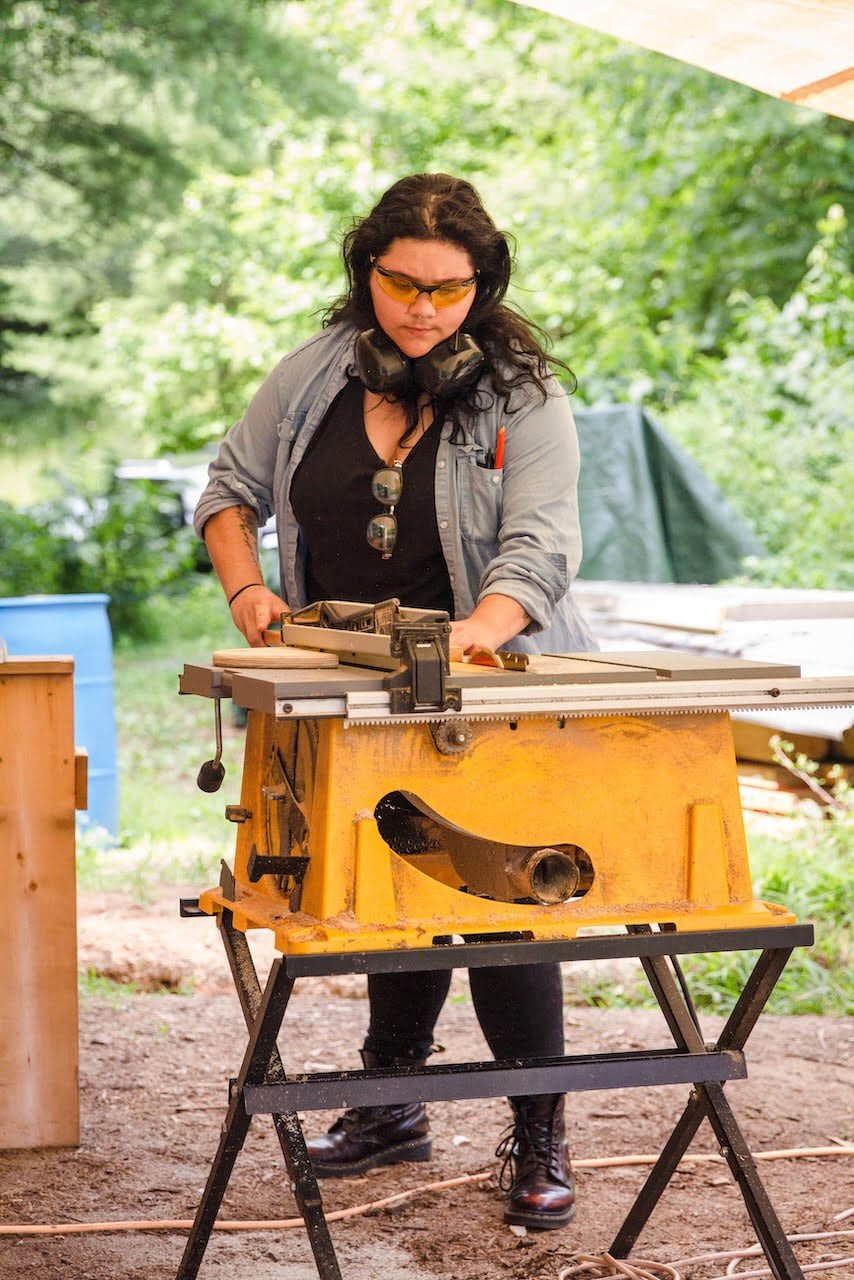There are just eight tools needed to build a tiny house, and you can buy them all for under $500. In addition to these basics, there are other specialized tools that come in handy and can make things easier. Of course it’s important to learn proper and safe tool use, so that you can build your tiny house effectively and without injury.
In this post, we’ll share more about the eight essential tools needed to build a tiny house, plus eight others that can be great to have. We’ve included video clips about some of these tools that are excerpts from our comprehensive online Tiny House Academy. To see all 50+ tool videos in the program, plus a whole lot more, enroll in our online tiny house building class.


What tools are needed to build a tiny house?
The following eight tools make up our bare-bones tiny house building toolkit. They range from simple hand tools like the carpenter’s pencil and tape measure, to larger, more expensive power tools like the impact driver and circular saw. We’ve included current (2022) price ranges for each tool. This way, you get a sense of the investment that’s needed for building your tiny house. You can also read more on how much it costs to build a tiny house.
Essential tiny house tools
- Carpenter’s pencil ($0.99 for 1, $5 for a 10 pack)
- Tape measure ($20-$40)
- Chalk line ($9-$15)
- Level ($8-$50+)
- Speed square ($6-$20)
- Hammer ($10-$50)
- Impact driver ($100-$300)
- Circular saw ($100-$300)
Optional tools to build a tiny house
- Chop saw ($120-$650)
- Plumb bob ($6-$10)
- Drill ($50-$200)
- Reciprocating saw a.k.a. Sawzall ($100-$300)
- Jigsaw ($40-$200)
- Nail gun ($80-$400)
- Table saw ($120-$1,000+)
- Hand saw ($10-$100+)
Tiny house tool rentals
When you build your own tiny house, you’ll be using the eight basic tools pretty regularly. Therefore, it’s great to own or long-term-borrow these. On the other hand, the optional tools are more specialized and may not be needed as much. For example, the jigsaw is great for making curved cuts or fancy cutouts, but won’t be necessary for basic framing. In the case of these more specialized tools, renting them is a great option.
Most larger hardware stores have tool rental programs, and some places even have tool libraries. These are wonderful community resources where everyday folks can share tools. To find out if there’s a tool library near you, check out this tool library map. Our Asheville Tool Library boasts over 2,000 tools, volunteer opportunities, and chances to learn how to use tools. There, you’ll definitely find all the tools needed to build a tiny house, plus many more.
Tips for buying tools
When it comes to tools for building a tiny house, you get what you pay for. Sometimes, you can find good deals on used tools through flea markets or online marketplaces like Craigslist or FB Marketplace. These are especially great for smaller hand tools because you can inspect the whole tool and determine what shape it’s in, and potentially fix it if it’s broken. For power tools, it’s hard to tell how robust or worn-out the motor might be, which determines the tool’s remaining lifespan.
For most amateur builders, middle-of-the-road quality tools are just fine. Two power tools in particular are worth spending money on: the impact driver and circular saw. These are the most frequently used power tools while building a tiny house, so it makes sense to spend some money and get higher quality and durability.
Tools needed to build a tiny house
Carpenter’s pencil
The carpenter’s pencil is essential for marking where to cut, and can be used in other ways, too. It’s larger than your everyday pencil, and is rectangular instead of round. You can use a round, everyday pencil for carpentry, but the carpenter’s pencil has some advantages. For one, it won’t roll away if you put it down on a slanted surface while you’re building your tiny house. Also, the thicker lead writes on rough surfaces more easily. Finally, the carpenter’s pencil doubles as a convenient spacer, and it’s easy to sharpen with a utility knife.
Tape measure
You’ll be making measurements at every step of building your tiny house, from framing to finishing. A tape measure helps you do this accurately, so everything lines up. There are many different tape measures, of varying qualities and sizes. All of them have a flat little hook or tongue on the end that wobbles a little bit, this is normal! The movement makes up for the thickness of the tongue itself. For most projects, a 25’ tape measure is a great length. Longer is fine, but shorter isn’t great for a project as big as a tiny house. You can choose a tape measure that has metric measurements on one side and imperial on the other, or just whichever system you use on top.
Chalk line
The chalk line is unparalleled when you need to make a long, straight mark on a piece of wood, or any other material. It’s a simple, elegant little tool that’s basically just a container full of powdered chalk with a spool of string that feeds out through one side. To use it, you stretch the string across your surface, then simply snap the string so it drops calk along its length, marking a clear line.
Level
A level helps you determine if something is perfectly flat in relationship to gravity. This tool makes it possible to line things up in your tiny house so that everything is balanced, square, and straight. Specifically, a level is great for determining if something is horizontally flat, or level. It can also be used to measure the vertical level, or plumb (if something is straight up and down), but the plumb bob is a more specific tool for this dimension. There are many lengths of levels, from a short bullet or torpedo level, to very long framing levels. Likely, a 4’ level is all you’ll need for building a tiny house.
Speed square
This simple tool isn’t square at all, but triangular. However, being a 90 degree or “right” triangle, it’s used to measure and mark perfect square angles. Along with this, a speed square easily measures and marks other angles, so you can use it to prepare for any straight cut. While building materials may seem “square,” they’re rarely perfectly 90 degrees. In order to build a tiny house that’s strong, stable, and well-aligned, the speed square is indispensable.
Hammer
A hammer is one way to drive nails, and it’s also useful in other ways as you build your tiny house. For example, if a board is just a little off from where you want it, tapping it with a hammer can snug it into place. There are many kinds of hammers in the world, and all are quite useful. In order to build a tiny house, or any structure, a framing hammer is ideal. When choosing a hammer, it’s important to find one that’s heavy enough to pound in nails, but not too heavy for you. Hammering with an overweight hammer can damage your wrist and shoulder, not to mention it feels uncomfortable! Try out several hammers to decide what’s right for your body.
Impact driver
If you see one of these, you may think it’s a drill…but don’t be deceived. Impact drivers and drills look similar, but impact drivers are designed to drive screws, whereas drills are made for drilling holes. Another difference is that the impact driver has more torque, or twisting force. Both drills and impact drivers can do each others’ jobs, but they’re better at what they’re designed for. When you’re building your tiny house, you’ll need to drive screws much more often than drill holes, so if you only get one of these tools, this is the one to get.
Circular saw
This is the hand-held electric saw that many tiny house builders use most frequently. It’s a little larger than a soccer ball, on average, and can be used to make many kinds of cuts. In contrast, the chop saw and table saw, which we’ll mention below, are more specialized for certain cuts, and not others. What’s nice about the circular saw is that it’s extremely portable, relatively affordable, and quite versatile. However, it does require some skill when making long, straight cuts. Beware: this tool could easily cut your hand off! Make sure you learn safe and proper use before attempting to use the circular saw, or any power tool. For a nine-video series on the circular saw, plus in-depth lessons on every tool we cover in this post and more, enroll in our online tiny house building class.
Optional tools to build a tiny house
There are many many other tools that might come in handy while you’re building a tiny house. The following are our runners-up; they’re not needed in order to do the job, but they can make it a lot easier, and/or they’re important for specialized tasks.
Chop saw
A stationary power saw with a circular blade that’s excellent for making cross cuts, including at measured angles. Some versions of the chop saw are called sliding miter saws and they’re able to cut larger pieces.
Plumb bob
A simple weight, usually metal, at the end of a long string that’s used to measure “plumb” or vertical straightness in relationship to gravity.
Drill
A hand-held electric tool specifically designed for drilling holes that can also be used for driving screws.
Reciprocating saw a.k.a. Sawzall
A small saw with a short, thin blade that is most commonly used in demolition and remodeling. It can fit in small spaces and can cut through metal, plastic, wood, and other materials.
Jigsaw
Another small saw with a short, thin blade that’s essential for cutting fancy rounded edges, scrollwork, or any other decorative, curvy cuts.
Nail gun
A hand-held power tool that saves your shoulder, elbow and wrist if you’re driving lots of nails by replacing a hammer.
Hand saw
There are many kinds of hand saws and, put together, they can do everything that modern power saws can do, without the need for electricity!
Table saw
A large, free-standing saw that’s designed to make rip cuts and is amazing for cutting large pieces of plywood and other similar materials.
To learn much more about all of these tools, including safe and effective use, plus how to design and build your own ecological tiny house, enroll in our online tiny house building class!




